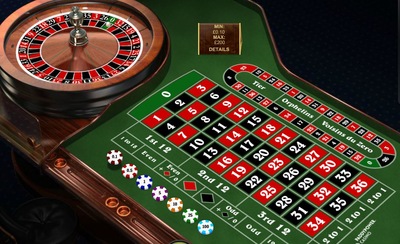 You might have seen an oval shaped racetrack on your roulette table and wondered what it was all about. It contains all of the same numbers as the wheel and the board with the same red and black sequence too, so what is its function?
You might have seen an oval shaped racetrack on your roulette table and wondered what it was all about. It contains all of the same numbers as the wheel and the board with the same red and black sequence too, so what is its function?
Some people wrongly believe that the racetrack is a way of placing different types of bets on the table, but that’s not quite true. The bets placed are all bets which can be placed on the regular betting board too, but the racetrack makes certain patterns of betting easier. Think of it as a betting tool which allows pre-set groups of bets to be made quickly.
The racetrack is made all the more confusing by the French writing that accompanies it, but this is just because it is more common in European and French versions of the game – roulette is French in origin after all.
Let’s now have a look at exactly what the racetrack can be used for and how it works.
How Does the Racetrack Work in Roulette?
The racetrack splits the numbers on the wheel into sections which makes betting on large groups of numbers much easier. These pre-set bets are all based on the way numbers are grouped on the roulette wheel.
The numbers are in the same order, it’s just the shape that is different.
Collectively, these bets are known as ‘call bets’ because you used to be able to call them out to the dealer rather than placing chips on the table. This isn’t really allowed any more as it crosses the line into betting on credit, but the name remains.
Les Voisins du Zero
Here you can see the option to bet on Les Voisins du Zero, which when translated means ‘neighbours of zero’.
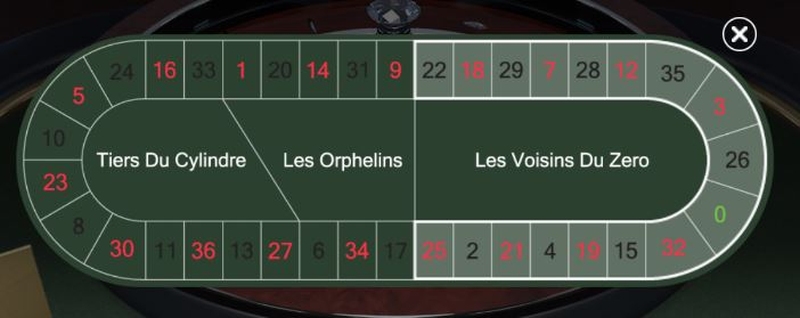
You can see that the numbers to the left and right of the zero are highlighted and these are the numbers covered by the bet. That gives you around 45% coverage of the board as there are 17 different numbers covered in this bet.
However, there are specific bet types used in the Voisins du Zero bet as well, namely splits, trios, and corners. You will make 12 bets all together, and two of them will take two betting units while all the others will take one.
You can see what we mean in this next image:

Tiers du Cylindre
This next bet translates as ‘third of the wheel’ and does pretty much what it says on the tin. It covers most of the opposite side of the wheel to the Voisins bet.
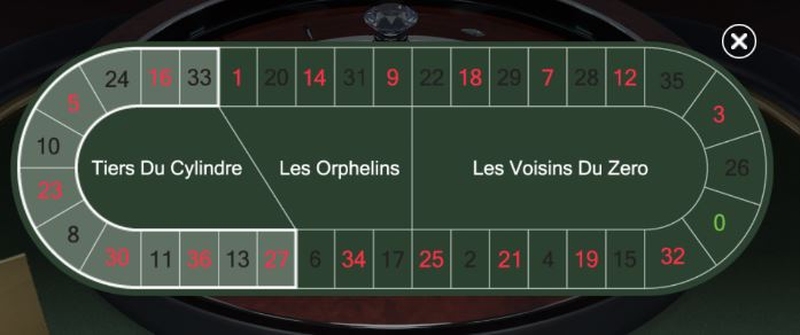
As you can see, Tiers – as it is most often called – includes 12 numbers and covers around 32% of the board, so it is a less ‘safe’ bet than Voisins.
However, it only takes six bets of one betting unit each so it is also a less expensive bet, and all of those bets are splits which pay out at 17:1.

Les Orphelins
The numbers left over and not included in either the Voisins or Tiers bet are known as Les Orphelins, which you might have already worked out translates as ‘the orphans’. It’s a fitting name if a little on the sombre side.
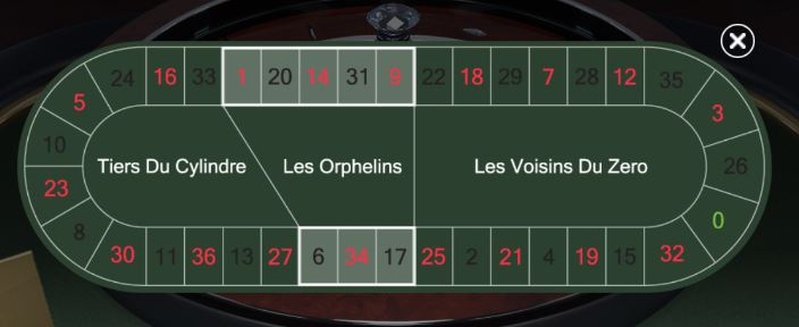
It’s the riskiest of all three bets because it only covers 8 numbers making up 21% of the board, so you will theoretically lose 4 times out of 5.
However, you will only be staking five betting units on Les Orphelins, and one of those bets is a straight up which pays out at 35:1 while the rest are splits.

Other Racetrack Bets
You can also use the racetrack to place a few other bets, but they are either not always included in the racetrack or do not count as call bets so tend to be thought of in a slightly different category.
Neighbour Bets
These are often seen as a class of their own because you could never call them out, you always had to place your chips manually.
Traditionally, a neighbour bet is where the two numbers either side of the chosen number on the wheel are also covered. This relates to their placement on the wheel, not in sequence if you were counting.
You can see what we mean below.
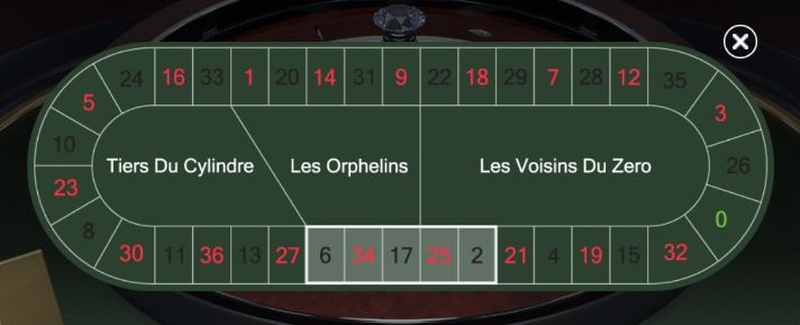
However, over time – and especially online – it has become possible to choose how many neighbours you want to include in your bet from one up to nine either side.
These bets are all straight ups so it could cost you anything from 3 to 19 betting units and see you covering anything from 8% to 51% of the board.

The image above shows a traditional neighbours bet covering five numbers and around 13% of the board.
Jeu Zero
Some roulette racetracks will include a Jeu Zero (Zero Game) section and others will not; the game we have been using in this article doesn’t, for example. It is basically a mini version of the Voisins bet.
It doesn’t stop you being able to make the bet, however, you will just need to place it manually, but since it only contains four betting units it won’t take very long.

As you can see, it covers 7 numbers including the zero which make up 18% of the board.
One of these bets is a straight up and the other three are splits.
Final
This one isn’t as common and actually doesn’t really have anything to do with the racetrack, but tends to get lumped in with racetrack bets regardless. It is betting on all numbers which end in the same final digit.
For example if you chose the number 3 then you would also bet on numbers 13, 23, and 33. Obviously though the wheel only goes up to number 36, so betting on numbers 7, 8 or 9 would have no effect in a finals bet.

All bets are straight ups so a Final bet costs 4 betting units and will give you in the region of 11% coverage.
Questions About the Racetrack
Can You Bet on More Than One Call Bet at the Same Time?
Yes, you can pretty much do what you like on a roulette table when it comes to the bets you make, but it might not always be wise. It’s about balance.
It’s all well and good betting on all three call bets and covering all the numbers on the board, but none of them pay out enough to cover what it will cost you to do that, so it’s a guaranteed way to lose money.
Can You Use the Racetrack and the Regular Board in Roulette?
Yes. Again, it’s totally up to you how you bet, so you could place an Orphelins for example and also bet on Red if that’s what you wanted to do.
